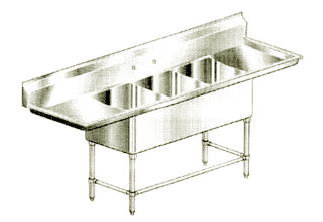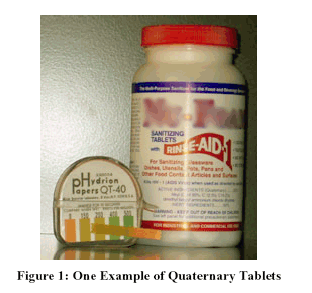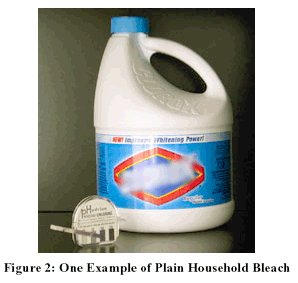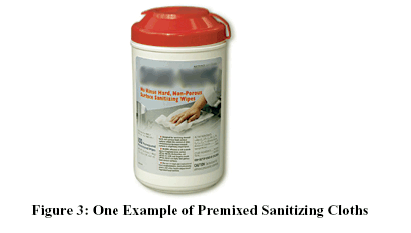Coffee & Beverage Service Requirements
Sink Requirements
 To safely serve coffee and other beverages to the public there are basic requirements. First, coffee must be prepared from a sanitary water source. If your coffee equipment is not directly fed from the clean water supply, draw water for the coffee only from the sanitizing compartment of a clean three bay sink or a dedicated prep sink. Do not fill coffee pots or wash coffee pots in a mop sink or a handsink. NEVER bring coffee equipment into a restroom.
To safely serve coffee and other beverages to the public there are basic requirements. First, coffee must be prepared from a sanitary water source. If your coffee equipment is not directly fed from the clean water supply, draw water for the coffee only from the sanitizing compartment of a clean three bay sink or a dedicated prep sink. Do not fill coffee pots or wash coffee pots in a mop sink or a handsink. NEVER bring coffee equipment into a restroom.
You must have a three bay sink to provide coffee for service to the public. A 3-bay has two drain boards and three compartments in one continuous unit. All equipment in a facility, except the handsinks, must be NSF or UL EPH approved.
A 3-bay sink with dual drain boards is required for a proper wash-rinse-sanitize process. The first bay is for washing in clean, soapy hot water (or specialized cleaning products provided by your coffee distributor), the second bay is for rinsing items in clean, clear hot water and the third bay is for submerging the coffee equipment in a sanitizing solution. Items then need to be air dried on the clean drain board until the next use.
Sanitation Requirements
Sanitizing in addition to cleaning is important to insure that any harmful germs that survived the washing process will not be passed on to other customers. Chemical sanitizers must be mixed to the proper concentration - if they are too weak, they will not be effective in killing viruses, bacteria and molds. If they are too strong they will leave a toxic residue which contaminates food.
There are only a few sanitizers approved for use in food service. These come with supporting, verifiable documentation, and are usually purchased through a distributor. There are also quaternary tablets and bleach. Quaternary tablets are sold under various names, but generally look similar to the packaging below. 
Quaternary Compounds
Quaternary compounds generally require 1-2 tablets per sink, depending on the sink size. Mix this type of sanitizer to a concentration of 200 PPM. To test your concentration, place a small amount of the fully mixed sanitizing solution in a small container and let cool to room temperature. Use a test strip made specifically for quaternary compounds as shown below. These test papers are generally orange and turn khaki-like brown when the sanitizer is at the proper concentration. Hold the paper in the sanitizer solution for 10 seconds, then compare the color change with the chart on the front of the package and adjust concentration to 200 PPM by adding either water if the color change is too dark, or more sanitizer if the color change is too light.

Household Bleach
Plain, household bleach, with no additives such as scents or other cleaning agents can also be used but don't mix the two types of sanitizers. Generally a very small amount of bleach (~1/2 of a capful of bleach to a small sink bay) is used. Mix to a concentration of 50-100 PPM, test with Chlorine test papers. There are no special testing procedures, just dip the strip in and compare the color change. If your paper turns color, then turns white again, your solution is much too strong and is bleaching out the paper.
Other Requirements
Coffee equipment must be washed, rinsed and sanitized at least once every 8 hours of continuous use or after each use, whichever is more often. Each time a pot or airpot is emptied, it must be washed, rinsed and sanitized prior to being refilled or reused.  To be licensed to sell/serve coffee to the public as part of your food business, the minimum licensing category is "Market".
To be licensed to sell/serve coffee to the public as part of your food business, the minimum licensing category is "Market".
Of major concern in the cleanliness of a coffee-service or other self-serve beverage dispensers are the areas the public touches to dispense the product. Buttons, handles and levers that are part of the dispensing process need to be frequently sanitized to prevent the spread of germs from one customer to another. There are many products on the market that are pre-mixed to sanitize for these purposes. One example is provided below. Spray cleaners not approved for food use should not be used because of the potential for the spray to reach food contact surfaces that could then contaminate the beverage.
Exception
THERE IS ONE EXCEPTION TO THESE REQUIREMENTS. If you have a coffee vending machine, these requirements do not apply. Vending machines are professionally installed, hard-plumbed, or have single use replaceable water tanks, CIP (clean in place) equipment. There are no removable parts and there is no requirement that you need to fill water tanks, etc. There is no handling of the coffee or any of the equipment. A professional who has the specialized equipment on a routine basis cleans CIP vending machines. Model styles change so if you have any questions about a particular model you are looking at, feel free to contact the Health Department to assist in evaluating if that particular model meets this requirement.
The licensing category for this type of equipment is "Prepack".